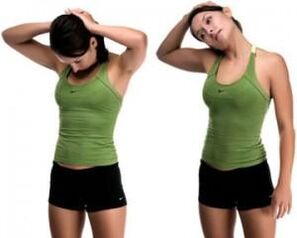What is the cause of accelerated osteochondrosis in the cervical region? What is the manifestation of its specific symptoms? How to cure cervical osteochondrosis yourself, in a quiet house? Many people with osteochondrosis want to hear the answer to these questions.

Osteochondrosis of the cervical region is the most common and unpleasant disease that affects modern young people between the ages of thirty and thirty-five. Cervical osteochondrosis develops due to a long stay in incorrect and tense postures - when working at a personal computer throughout the day, and also due to the habit of holding the phone on your shoulders. Quite often, this disease appears due to prolonged exposure to vibration, or rather, if powerful construction equipment or frequent driving is used during work. Also, this disease develops with poor posture, uncomfortable beds, a sedentary lifestyle, hereditary predispositions and other factors. Most often, in people with this disease, the neck hurts.
Osteochondrosis of the neck is considered a degenerative and dystrophic lesion of the intervertebral discs of the cervical spine. It appears due to metabolic disorders in the cervical spine, in connection with which there is a change in the structure of the intervertebral disc, that is, a special joint between the vertebrae.
Symptoms of cervical osteochondrosis are significantly different from osteochondrosis in other areas. This is one of the most dangerous types of osteochondrosis, since the nerve root of the spinal cord is violated and the blood supply to the brain is disturbed due to the compression of blood vessels. The reason for this is the peculiarity of the structure of the spine in the neck.
The large artery that supplies the brain is vertebral and passes through the opening of the cervical vertebra process. A pathological change in it leads to the growth of bone and fibrous tissues and compression of the artery. Due to the displacement of the spine, the normal functioning of these arteries is also disturbed.
The structure of the cervical spine is slightly different - the vertebrae are in close contact with each other. With even minor pathological changes, the normal functioning of all departments is disturbed - nerves and vessels are squeezed and displaced. As a result, the functions are disturbed - the sensitivity of the skin is disturbed, signs of dizziness are observed. You will have ringing in the ears, headaches, great fatigue will appear, your sight and hearing will deteriorate and you will stagger when walking.
The most important symptoms are:
- Pain in the neck, shoulders and arms. You will feel muscle weakness, cracking in the neck when you turn your head.
- Sensation of drawing pain in the heart. You will feel pain in your left hand. You will feel burning and pain in your shoulder blades.
- Do not be surprised by occasional headaches and increased fatigue, as well as feelings of weakness.
- The pain is painful. Difficulty moving the head.
- Neck pain radiates to the arm, which can lead to numbness in the fingers.
- Hearing and vision will deteriorate, pain in the hands will occur, the work of the heart and lungs will be disturbed, dizziness, nausea, numbness of the tongue and face will appear.
Treatment of cervical osteochondrosis

At first, osteochondrosis takes a mild form and does not cause a person any discomfort. Drug treatment is not required at this stage, it is enough to carry out preventive measures in order to avoid more serious complications. It is necessary to improve working conditions, revise the way of life and abandon bad habits.
Be active, exercise in the morning, follow a diet, quit smoking and avoid heavy lifting. Keep a straight posture, adopt the correct posture when sitting and lying down. Sign up for a therapeutic gymnastics class.
Over the years, cervical osteochondrosis can develop and evolve into a more complex form. Then the treatment is carried out using a conservative method. At this stage, you will need to wear special collars, do physiotherapy, get a massage.
In the most severe cases, the use of drug therapy will be required, that is, the treatment will already be with the help of painkillers, antispasmodics, nonsteroidal anti-inflammatory drugs.














































